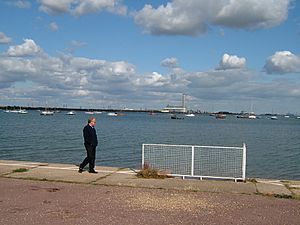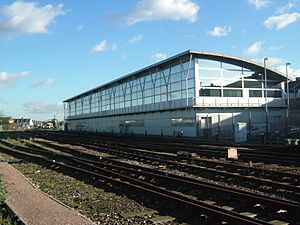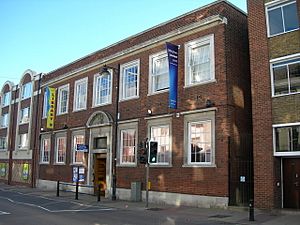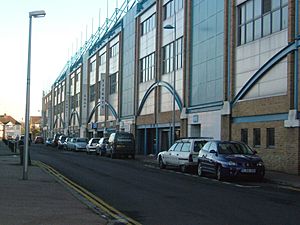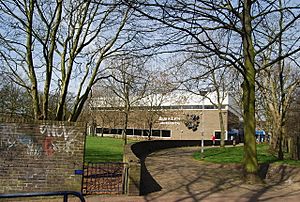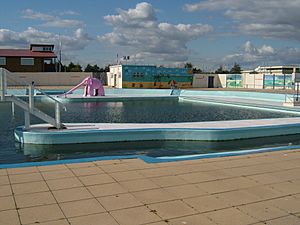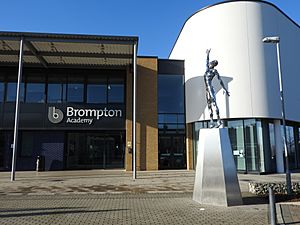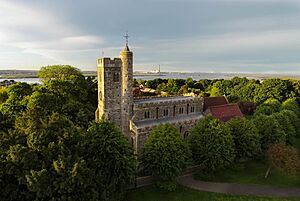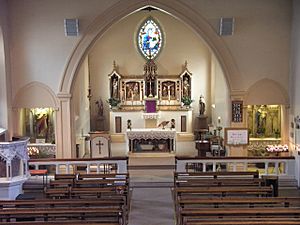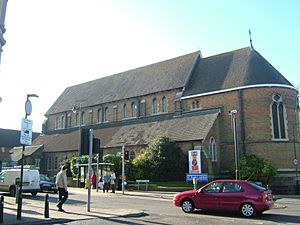Gillingham, Kent facts for kids
Quick facts for kids Gillingham |
|
|---|---|
| Town | |
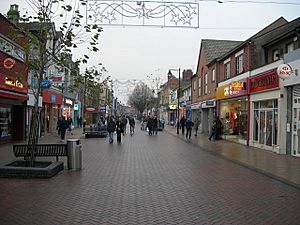 High Street, Gillingham |
|
| Population | 108,785 (2020 ONS) |
| OS grid reference | TQ775675 |
| • London | 35.6mi |
| Unitary authority | |
| Ceremonial county | |
| Region | |
| Country | England |
| Sovereign state | United Kingdom |
| Post town | GILLINGHAM |
| Postcode district | ME7 |
| Dialling code | 01634 |
| Police | Kent |
| Fire | Kent |
| Ambulance | South East Coast |
| EU Parliament | South East England |
| UK Parliament |
|
Gillingham (pronounced JIL-ing-əm) is a town in Kent, England. It's part of a larger group of towns that includes Chatham, Rochester, Strood, and Rainham.
Gillingham is the biggest town in the Medway area. In 2020, about 108,785 people lived there.
Contents
- What's in a Name? The History of Gillingham's Name
- How Gillingham Grew: Town Status Over Time
- Exploring Gillingham's Location and Weather
- Gillingham's Past: A Look at its History
- Gillingham's Economy: Jobs and Shops
- Getting Around: Transport in Gillingham
- Culture and Fun: What to Do in Gillingham
- Local Media: News and Entertainment
- Education: Schools and Colleges in Gillingham
- Religion: Places of Worship
- Military: Royal Engineers
- Famous People from Gillingham
- Twin Towns: Gillingham's International Friends
- See also
What's in a Name? The History of Gillingham's Name
The name Gillingham comes from an old English word. It means "the home of Gylla's people." Gylla was likely a person's name.
Other towns like Gillingham in Dorset and Gillingham in Norfolk have the same name origin. Even though they are spelled the same, they are pronounced differently!
How Gillingham Grew: Town Status Over Time
Gillingham became an "urban district" in 1894. This meant it had its own local government. In 1903, it became a "municipal borough," which is a more important type of town. John Robert Featherby was the first mayor.
In 1928, the nearby town of Rainham joined Gillingham. Later, in 1998, Gillingham became part of the larger Medway area. This new area is run by a single council.
The Town Hall: A Place for Local Government
The Municipal Buildings on Canterbury Street were built for Gillingham's council. They opened in 1937. Before World War II, air raid sirens were put on the buildings. An underground control centre was also built there.
After Gillingham joined with Rochester to form Medway Council in 1998, the buildings were still used for a while. But later, the council moved to Chatham. The old Municipal Buildings were sold in 2008. They are now a care home for older people.
Exploring Gillingham's Location and Weather
Gillingham grew along the main road from Brompton. It also grew near the railway station. Another important road, Watling Street, linked Chatham with Dover. All these smaller communities eventually joined to form the Gillingham we know today.
Gillingham's Climate: What's the Weather Like?
Gillingham has an oceanic climate, which means it has mild winters and warm summers. It's similar to most of the United Kingdom. Because it's in the south and near the sea, it's one of the warmer places in England.
| Climate data for Gillingham F.C. (1991–2020) | |||||||||||||
|---|---|---|---|---|---|---|---|---|---|---|---|---|---|
| Month | Jan | Feb | Mar | Apr | May | Jun | Jul | Aug | Sep | Oct | Nov | Dec | Year |
| Mean daily maximum °C (°F) | 8.3 (46.9) |
8.7 (47.7) |
11.4 (52.5) |
14.5 (58.1) |
17.9 (64.2) |
21.1 (70.0) |
23.6 (74.5) |
22.9 (73.2) |
20.2 (68.4) |
16.0 (60.8) |
11.6 (52.9) |
8.8 (47.8) |
15.4 (59.7) |
| Mean daily minimum °C (°F) | 2.8 (37.0) |
2.4 (36.3) |
4.0 (39.2) |
5.9 (42.6) |
8.6 (47.5) |
11.6 (52.9) |
14.0 (57.2) |
13.9 (57.0) |
11.4 (52.5) |
8.7 (47.7) |
5.4 (41.7) |
3.1 (37.6) |
7.7 (45.9) |
| Average rainfall mm (inches) | 68.6 (2.70) |
45.3 (1.78) |
35.9 (1.41) |
41.4 (1.63) |
45.7 (1.80) |
44.0 (1.73) |
39.1 (1.54) |
46.8 (1.84) |
47.9 (1.89) |
60.0 (2.36) |
66.9 (2.63) |
59.9 (2.36) |
601.5 (23.68) |
| Mean monthly sunshine hours | 45.8 | 67.8 | 111.4 | 176.6 | 190.7 | 197.4 | 205.0 | 196.6 | 159.8 | 117.2 | 66.5 | 51.2 | 1,586 |
| Source: Met Office | |||||||||||||
Gillingham's Past: A Look at its History
Gillingham is mentioned in the Domesday book from 1086. It was named after a warlord called Gyllingas. He was known for shouting and screaming when leading his warriors into battle!
After the Norman Conquest, Gillingham was given to William I's half-brother, Odo. He rebuilt the church and built a palace. At that time, Gillingham was a small village with many farms.
William Adams, a famous sailor, was baptised in Gillingham in 1564. He wrote that Gillingham was "two English miles from Rochester and one mile from Chatham, where the King's ships do lie."
The Strand area of Gillingham was once owned by the Davenport family. They were important people, with one even becoming a Mayor of Gillingham. They also invested in the Chatham Dockyard.
In medieval times, the Grange part of Gillingham was important for sea trade. This continued until the 1940s. A large part of Chatham Dockyard was actually in Gillingham. When the dockyard closed in 1984, two-thirds of it was within Gillingham's borders. Queen Elizabeth I started the dockyard.
In 1667, a Dutch fleet sailed up the River Medway. They attacked Gillingham in what is known as the raid on the Medway. The Dutch eventually left, but it was a big embarrassment for the Royal Navy.
Defending the Dockyard: Forts and Lines
During the Seven Years' War (which started in 1756), the government built defences for the dockyard. The Chatham Lines of Defence were built by 1758. They were over a mile long and protected the dockyard from land attacks. One of the forts was Fort Amherst. Today, these lines are part of the Great Lines Heritage Park.
When war with France started again in 1778, more defences were needed. Fort Amherst was improved, and new forts were built. This work, and the growing dockyard, meant more homes were needed for workers. This led to the growth of New Brompton. By 1851, 9,000 people lived there.
Gillingham was still a small village, but it eventually grew and joined with New Brompton. The whole area then became known as Gillingham. By 1891, the population was 27,809, and by 1901, it was 42,530.
After World War I, a naval war memorial was built on the Great Lines in 1919. It's a white stone tower. More parts were added in 1945 to remember those who died in World War II.
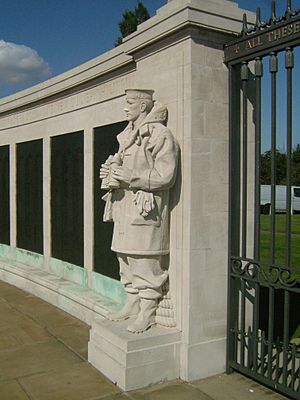
Sad Events: Disasters in Gillingham's History
Gillingham has seen two major disasters:
- In 1929, a fire brigade demonstration went wrong, and 15 people died.
- In 1951, 24 Royal Marine cadets (aged 10 to 13) were killed in a bus accident.
Gillingham's Economy: Jobs and Shops
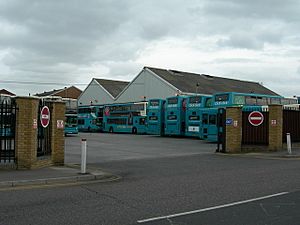
The main source of jobs used to be the Chatham Dockyard. When it closed in 1984, many people lost their jobs.
Since then, Gillingham has worked to create new jobs. The Gillingham Business Park was set up to bring in new companies. This helped the town's economy grow again.
Gillingham also has a Gillingham Marina for boats. It's an important shopping area for Medway. There's a big street market in the High Street on Saturdays and Mondays. It's the busiest market in all of Medway!
Getting Around: Transport in Gillingham
Roads: Connecting Gillingham to Other Places
The old Roman road called Watling Street goes through Gillingham. This road was the main route to Dover until the M2 motorway opened in the 1960s.
In 1996, the Medway Tunnel opened. This gave Gillingham another way to connect to the M2 and Strood.
Railways: Trains to and from Gillingham
The railway line between Chatham and Faversham opened in 1858. A station called New Brompton was built in Gillingham. This station served the homes of dockyard workers. It later became Gillingham railway station.
Train services got much better in 1939. Gillingham became the end point for the electric train system of the Southern Railway.
Trams: Old Ways to Travel
Gillingham also had an electric tram system. It was run by the Chatham and District Light Railways Company from 1902 to 1930.
Culture and Fun: What to Do in Gillingham
Library: A Place to Read and Learn
Gillingham Public Library is located in the High Street. It's a great place to find books and learn new things.
Sport: Get Active in Gillingham
Gillingham is home to Gillingham F.C., a professional football team. They play at Priestfield Stadium. The team joined the Football League in 1920. They have moved between different divisions over the years. In the 1999–2000 season, they reached the second tier of English football. They were promoted to League One (the third tier) in 2013.
The town has a big sports centre called Medway Park (formerly Black Lion Leisure Centre). It has three indoor swimming pools, a gym, a sports hall, and squash courts. There's also Jumpers Rebound Centre nearby, which is famous for trampolining.
At The Strand, there's an outdoor sports centre. You can take sailing and motorboat courses there. The Strand Leisure Park also has an open-air swimming pool right by the River Medway. Plus, there are tennis courts and a small railway.
Gillingham Ice Bowl is the home of the Invicta Dynamos ice hockey club. The Ice Bowl was opened by Queen Elizabeth II in 1984.
Modern Pentathlon World Cup 2010
Medway Park hosted the Modern Pentathlon World Cup in 2010. This sport combines five different events: fencing, swimming, horse riding, shooting, and running.
- In the Women's Final, Amelie Caze from France won gold.
- In the Men's Final, Ádám Marosi from Hungary won gold.
Modern Pentathlon European Championships 2011
Medway Park also hosted the European Championships in 2011.
- Andrei Moiseev from Russia won gold in the Men's Final.
- Lena Schoneborn from Germany won gold in the Women's Final.
Rugby League: Medway Dragons
The Medway Dragons Rugby League Football Club is based in Brompton. It started in 2007. The Dragons have teams for all ages, from Under 6 to adults. They even have a Wheelchair Rugby League Team! Their top team won championships in 2016 and 2021.
Local Media: News and Entertainment
Television: What's on TV?
Local news and TV shows for Gillingham come from BBC South East and ITV Meridian. They are broadcast from the Bluebell Hill TV tower.
Newspapers: Keeping Up with Local News
Local newspapers for Gillingham include the Medway Messenger. There are also free newspapers like the Medway Extra.
Radio: Tune In!
The local commercial radio station is KMFM Medway. You can also listen to community radio station Radio Sunlight. Other stations like BBC Radio Kent and Heart can be heard too.
Education: Schools and Colleges in Gillingham
Gillingham has many schools. The Gillingham Boys Grammar School opened in 1923. It later became The Howard School in 1975. Other secondary schools include Rainham Mark Grammar School, Brompton Academy, Rainham Girls School, Chatham Grammar School for Girls, and the Robert Napier School.
There are also several primary schools, like Twydall Infant School, St. Mary's, and Napier Community Primary Schools.
Gillingham is home to MidKent College, which offers further education courses. It also has Universities at Medway, a campus where students can study at the University of Kent, Canterbury Christ Church University, and University of Greenwich.
Religion: Places of Worship
Gillingham has many churches for different Christian groups. There are three Church of England churches: St. Mary Magdalene, St. Mark's, and St. Augustine's. There are also Baptist, Methodist, and Roman Catholic churches.
The Parish Church of St Mary Magdalene is the oldest building in Gillingham. It was built by the Normans in the early 1200s. A tower was added in the 1400s. It has beautiful stained glass windows.
Our Lady of Gillingham Roman Catholic Church was built in 1896. It was built to serve the many new workers at Chatham Dockyard. A Catholic school was also started there in 1894.
Gillingham also has a Jāmi’ah mosque and a Hindu Sabha Mandir.
A man named James Jershom Jezreel started building a large tower called Jezreel's Tower in the 1800s. It was never finished and was taken down in 1961. You can still find Jezreels Road in Gillingham.
Military: Royal Engineers
Brompton Barracks has been the home of the Royal Engineers for a long time. Today, Gillingham is also home to the Royal Engineers Museum.
Famous People from Gillingham
Many interesting people have lived in or are connected to Gillingham:
- William Adams – a sailor who became an advisor to a Japanese leader.
- Ryan Bertrand – a football player who won the UEFA Champions League with Chelsea FC.
- David Frost – a famous television presenter.
- James Jordan – a professional dancer from Strictly Come Dancing.
- James McCudden – a brave flying ace from World War I.
- Brian Moore – a well-known sports commentator.
- Gary Rhodes – a famous chef.
- Rik Waller – a singer from the TV show Pop Idol.
Twin Towns: Gillingham's International Friends
Gillingham has special connections with two towns in Japan:
 — Ito
— Ito — Yokosuka (This is where William Adams, the sailor, is buried!)
— Yokosuka (This is where William Adams, the sailor, is buried!)
See also
 In Spanish: Gillingham (Kent) para niños
In Spanish: Gillingham (Kent) para niños



